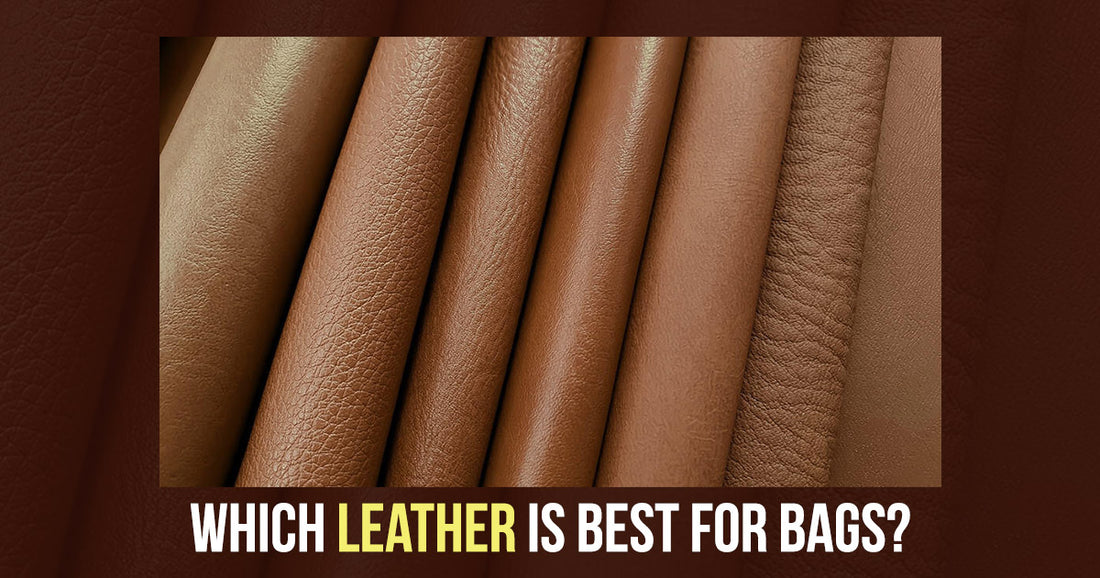Think about the sort of leather used when buying a purse made of leather, such as suede, top grain, rectified grain, and genuine leather. Because full grain is better and can be used in more applications, it is the recommended option for bags.
Full-grain is the highest quality and most sought-after due to its tenacity and natural qualities. It originates just beneath the hair and develops a desirable patina with usage.
Cowhide leather is the ideal material for handbags due to its resilience, sophistication, suppleness, flexibility, and progressive patina formation. It doesn't absorb water, keeping bags dry and protecting them from sun and heat damage. Cowhide leather bags can last three to four decades for harsh use.
Major companies use this leather to create various styles, and each hide has unique characteristics. Cowhide leather purses can be customized with blacks, whites, or chestnut browns to enhance your appearance. They are suitable for various events and uses and can be costly but last a lifetime. Investing in a fashionable and practical cowhide leather bag with high-quality hardware is always a good idea.
What type of leather is perfect for bags?
Several varieties of leather are available, each with special traits and attributes. The many kinds of leather are described here, along with the reasoning that cowhide is the greatest material for leather bags.
Different types of animal leather:
While cowhide leather is the most popular material for leather bags, there are various options to pick.
1. Goatskin leather
Goatskin leather is warm, breathable, and comfortable and is made by rolling and ironing the corners of goatskin, a soft, malleable substance.
Goatskin leather, known for its suppleness and versatility, is widely used by local craftspeople for bags due to its ease of production. The leather's appearance and feel are influenced by goats' wear and tear. Goatskin purses are water-resistant, making cleaning easy. Applying leather conditioners can extend the lifespan of these bags.
The benefits of goat leather
- Fairly priced
- Vintage appearance
- Lightweight
- Gentle Support
- Water-resistant
Drawbacks of leather from goats
- Remain for two to four years, according to lining and usage.
- It expands as it becomes older.
- It smells strongly, if not fully tanned.
- Reduced opposition
- It darkens as it ages.
- Goatskin cuts and markings result in minor blemishes and scrapes.
2. Cowhide leather
Cowhide leather is a popular type of leather produced through tanning and finishing processes. It can be finished in various ways and dyed in multiple colors to mimic other leather types. The quality and size of cowhide leather depend on the type of cow used and the tanning method used. The leather's texture can vary.
Cowhide leather is a durable and eco-friendly material, suitable for bags because of its natural texture and flexibility. Made from byproducts of meat, cowhide bags are a worry-free way to transport bulky items. They produce less pollution than extraction techniques and are hypoallergenic, repelling dust, grime, and liquids. Many well-known brands use cowhide leather for bags due to its beautiful texture and ability to last over ten years with proper care.
Advantages of Cowhide:
- Durability
- Density
- Power
- Adaptability
- Resistant to mechanical harm and environmental variables
- Enduring and attractive.
Drawbacks of cowhide:
- High cost
- Adverse environmental effects from chromium-based tanning.
3. Camel leather
Camel leather, a unique type of leather used in bags, resembles nubuck and buffalo leather. Its hardness varies based on habitat, but it is known for its durability. Full-grain camel skins resemble pebbles and provide a "honey" tint and distinctive patina from UV exposure, resembling older species' skins.
Producers use camel leather to create robust yet lightweight bags because it is incredibly resilient and durable. It ages well and has a tough appearance. Camel leather purses are, therefore, a long-term investment.
The finish, applied to the bags by rubbing linseed oil, gives the leather more weather resilience and prevents cracking.
Benefits of leather from camels
- Robust
- Lightweight
- Eco-Friendly
- Exquisite texture
Drawbacks of leather from camels
- Powerful smell
- Expensive
- Limited supply
4. Buffalo hide/bison leather.
Buffalo hide/bison leather is a distinctive and long-lasting option for bags, despite these disadvantages.
Domestic buffalo skins are used to make buffalo leather. It is renowned for both its remarkable endurance and unique grain pattern. This flexible and soft leather is perfect for high-end leather accessories, outerwear, and shoes.
Because of its longer tanning process and thicker epidermal layer, buffalo leather is a strong and durable material. Unlike the suppleness of cowhide leather, this is the strongest leather used in bags.
Advantages of Bison Leather
- Robust
- Durable Tanning from Organic Sources
- Elegant appearance Excellent texture
- Delicate grain
Drawbacks of Bison Leather
- Not very flexible
- Heavy appearance
- Expensive
- Thick thread makes stitching difficult.
Which grain is best for leather bags?
Now that you know the many kinds of leather, let's discuss the ideal grain for leather bags. We'll talk about the many different types of grain below:
1. Top grain
Creating top-grain leather involves first sanding and polishing the surface to remove any defects that may have been present in the top layer. This gives the leather a uniform, smooth look, but it may also remove some of its organic character and texture.
Top grain leather is the second layer of concealment, sanded and buffed to remove flaws and create a consistent appearance. However, it is less resilient and ages faster than full-grain leather. Top-grain is often used for high-quality products due to its flexibility, affordability, and thinnerness. Corrected leather is a variation that undergoes a long process to remove natural markings.
Advantages of top-grain leather.
- Simple to use.
- Consistent results after processing
- More durable than inferior quality leather kinds
- Can be colored
- Can be made to seem like exotic leather.
Drawbacks of top-grain leather
- Not as robust
- Unable to absorb bodily oil .
- Will not develop a patina.
- Breaks carelessly.
- Brief life expectancy
2. Full grain
Making full-grain leather involves preserving the complete grain, flaws, and all. This keeps the leather's hardness and resilience while giving it a more organic, textured look.
Full-grain leather is the outermost layer of the hide, treated with soluble aniline colors or semi-aniline dye for protection and stain resistance. It is the strongest and most resilient component, resistant to dampness and imperfections. Each fragment has a unique appearance, conveying the animal's story. As it ages, it becomes more exquisite and acquires a patina.
Benefits of Full Grain Leather
- Unchanged grain
- Durable
- Greater longevity
Drawbacks of full-grain leather
- Natural appearance
- Visible flaws
- Costly
- Delicate
3. Cross-grain
Cutting leather across its grain produces cross-grain leather with a distinctive pattern and feel. However, this kind of grain may stretch more easily than other kinds of leather and need to be stronger.
Cross-grain leather is a popular type of embroidered leather used to conceal flaws in genuine hide. Its smooth texture is achieved by exposing it to longer running drum time, resulting in slight shrinkage and bubbles, making it popular for purses.
Benefits of cross-grain leather
- Softness
- Thickness
- Durability
- Attractiveness
Drawbacks of cross-grain leather
- Low quality
- Difficult to clean
- Flimsy
4. Suede leather
Turning leather inside out produces a distinctive, velvety skin known as suede leather. With a shaggier texture than napped skins, it is split leather derived from sheep, calves, goats, and deer. Thick skins are not suited for the soft, thin material created by cutting the thin inner layer. Because suede is so soft, it is incredibly high-quality and resistant to harm. However, the animal and its age impact its suppleness and softness. The choice of suede kind is a question of taste.
Benefits of suede leather
- Ideal appearance and texture
- Exceptional due to nap
- Sturdy
Drawbacks of leather suede
- Thin
- Not as robust as other kinds of leather
- Weak
- Traps oil, moisture, and grime.
- Prone to stains and damage
5. Genuine leather
Any leather derived from animal hide is referred to as genuine leather. Authentic leather can differ significantly in quality and attributes based on its kind and processing.
Genuine leather is low-quality, split leather with multiple layers of inferior leather painted and adhered using adhesive. It is often used in low-cost goods without considering quality. The layers between suede and top grain can be extracted, depending on skin thickness. Genuine leather can also be combined with synthetic materials, adhesives, and leftover leather.
Benefits of genuine leather
- Low-cost Leather-like appearance and texture
- Simple to maintain and long-lasting with the proper care.
Drawbacks of genuine leather
- Gets stretch marks.
- Deteriorating appearance
- It makes you feel hot and sticky in the summertime.
- Sellers frequently overpay and trick clients.
6. Faux leather
Faux leather, a cheaper alternative to leather is used in making market goods like sofas, chairs, etc.
Pros of Faux Leather
- More affordable than genuine leather.
- Versatile and requires minimal maintenance.
- Stain-resistant and easy to sew and trim.
Cons of Faux Leather
- Non-stretchable, non-breathable, and non-wearable.
- Lacks lustre and patina over time.
- Not tear/puncture resistant like genuine leather.
- Not environmentally friendly due to waste generation.
- Not skin friendly and only lasts for a short time.
- Peel-like and susceptible to fractures and tears.


